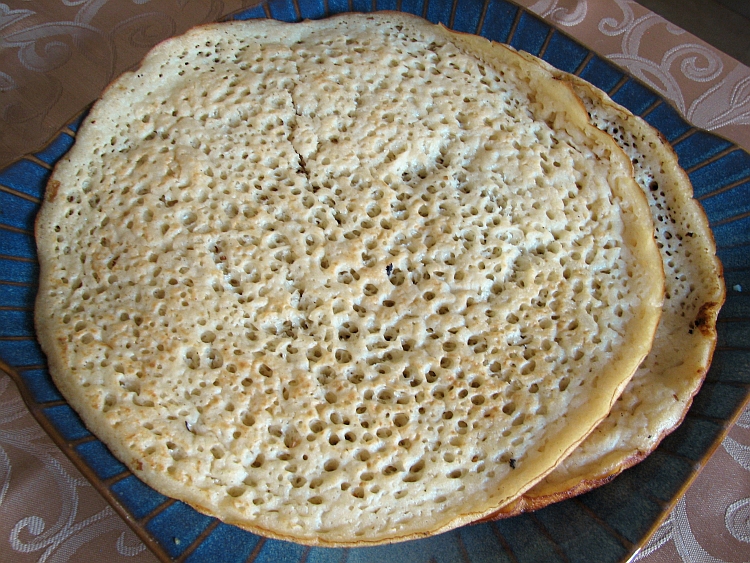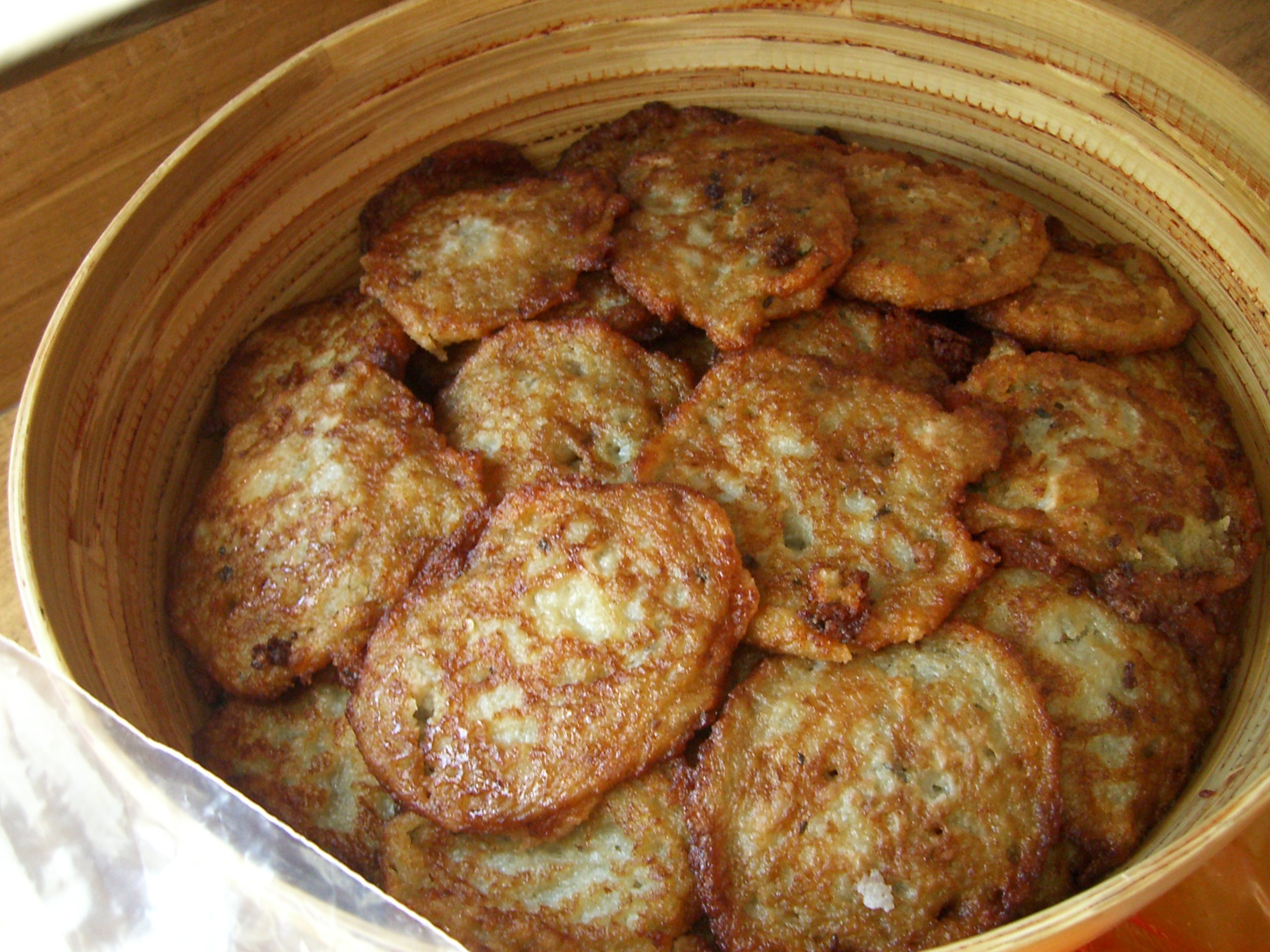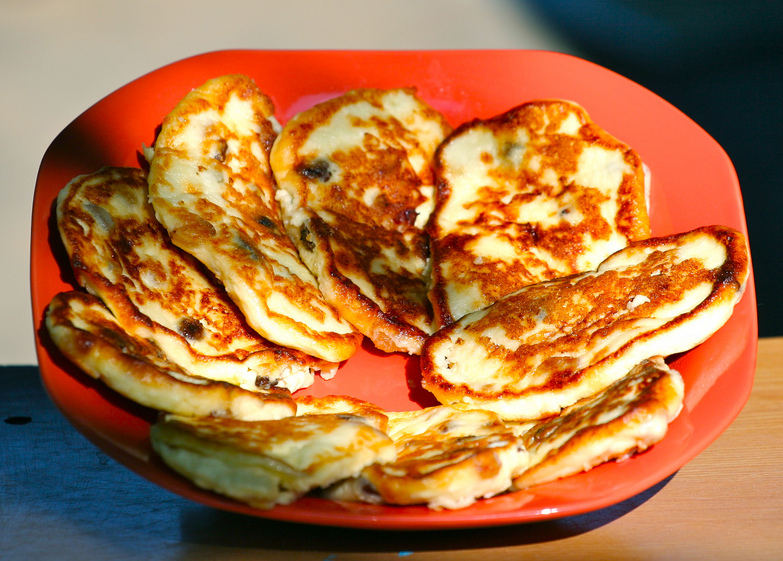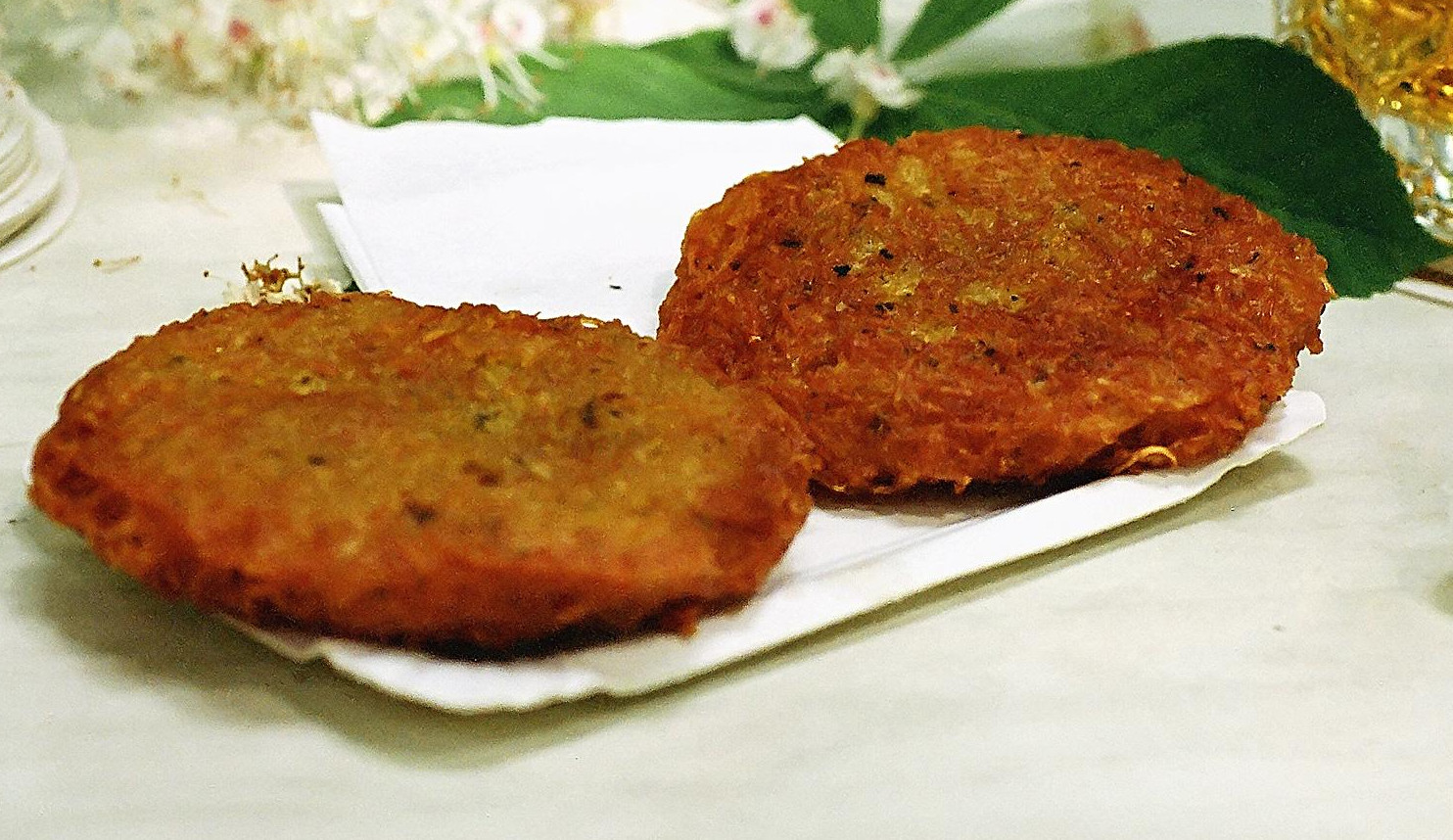|
Oladyi
Oladyi (russian: оладьи pl., diminutive: оладушки, ''oladushki'', sg. оладья, ''oladya'') are small thick pancakes or fritters common in Russian cuisines. The batter for oladyi is made from wheat or (nowadays more rarely) buckwheat flour, eggs, milk, salt and sugar with yeast or baking soda. The batter may also be based on kefir, soured milk or yoghurt. It may contain various additions, such as apple or raisins. Oladki are usually served with smetana (sour cream), as well as with sweet toppings such as jam, powidl, honey etc. Savoury versions may be served with caviar, similarly to blini. Generally, the term ''oladki'' in Eastern Slavic cuisines may also denote fritters made with other ingredients, e.g. potato pancakes (картофельные оладьи), carrot fritters (морковные оладьи), bean pancakes (оладьи из бобовых), rice pancakes (рисовые оладьи), summer squash fritters (кабачковые ола� ... [...More Info...] [...Related Items...] OR: [Wikipedia] [Google] [Baidu] |
Pancake
A pancake (or hotcake, griddlecake, or flapjack) is a flat cake, often thin and round, prepared from a starch-based batter that may contain eggs, milk and butter and cooked on a hot surface such as a griddle or frying pan, often frying with oil or butter. It is a type of batter bread. Archaeological evidence suggests that pancakes were probably eaten in prehistoric societies. The pancake's shape and structure varies worldwide. In the United Kingdom, pancakes are often unleavened and resemble a crêpe. In North America, a leavening agent is used (typically baking powder) creating a thick fluffy pancake. A ''crêpe'' is a thin Breton pancake of French origin cooked on one or both sides in a special pan or crepe maker to achieve a lacelike network of fine bubbles. A well-known variation originating from southeast Europe is a '' palačinke'', a thin moist pancake fried on both sides and filled with jam, cream cheese, chocolate, or ground walnuts, but many other fillings ... [...More Info...] [...Related Items...] OR: [Wikipedia] [Google] [Baidu] |
Pancake
A pancake (or hotcake, griddlecake, or flapjack) is a flat cake, often thin and round, prepared from a starch-based batter that may contain eggs, milk and butter and cooked on a hot surface such as a griddle or frying pan, often frying with oil or butter. It is a type of batter bread. Archaeological evidence suggests that pancakes were probably eaten in prehistoric societies. The pancake's shape and structure varies worldwide. In the United Kingdom, pancakes are often unleavened and resemble a crêpe. In North America, a leavening agent is used (typically baking powder) creating a thick fluffy pancake. A ''crêpe'' is a thin Breton pancake of French origin cooked on one or both sides in a special pan or crepe maker to achieve a lacelike network of fine bubbles. A well-known variation originating from southeast Europe is a '' palačinke'', a thin moist pancake fried on both sides and filled with jam, cream cheese, chocolate, or ground walnuts, but many other fillings ... [...More Info...] [...Related Items...] OR: [Wikipedia] [Google] [Baidu] |
Potato Pancake
Potato pancakes are shallow-fried pancakes of grated or ground potato, matzo meal or flour and a binding ingredient such as egg or applesauce, often flavored with grated garlic or onion and seasoning. They may be topped with a variety of condiments, ranging from the savory (such as sour cream or cottage cheese), to the sweet (such as apple sauce or sugar), or they may be served plain. The dish is sometimes made from mashed potatoes to make pancake-shaped croquettes. Some variations are made with sweet potatoes. In different cultures Potato pancakes are associated with various European cuisines, including Irish (as Boxty) German and Austrian (as ', ', ', ' and '), Dutch (as ', ', '), Belarusian (as '), Bulgarian (as '), Czech (as '','' ' or ''vošouch''), Hungarian (as ', and other names), Jewish (as ', yi, לאַטקע, he, לביבה ', plural '), Latvian (as '), Lithuanian (as '), Luxembourg ('), Polish (as '), Romanian (as ''tocini'' or ''tocinei''), Russ ... [...More Info...] [...Related Items...] OR: [Wikipedia] [Google] [Baidu] |
Syrniki
Syrniki ( be, сырнікі; russian: сырники) or syrnyky (Ukrainian: сирники) are fried Eastern Slavic Tvorog pancakes. In Russia, they are also known as tvorozhniki (творо́жники). They are a part of Belarusian, Russian, Ukrainian, Latvian (''biezpiena plācenīši''), Lithuanian and Serbian cuisine. Their simplicity and delicious taste have made them very popular in Eastern Europe. Etymology The name ''syrniki'' is derived from the Slavic word ''syr'' (сыр), stand for soft curd cheese. The Ukrainian language retains the old Slavic sense of the word, as in ''domashnii syr'' (домашній сир, literal translation 'domestic cheese'), whereas in Russian, another old Slavic word for curd cheese, namely the word ''tvorog'' (творог), is used. Preparation Syrnyky or tvorozhniki are made from Tvorog, mixed with flour, eggs and sugar, sometimes adding vanilla extract. Cottage Cheese is suggested as a substitute for the '' tvorog''. ... [...More Info...] [...Related Items...] OR: [Wikipedia] [Google] [Baidu] |
Potato Pancake
Potato pancakes are shallow-fried pancakes of grated or ground potato, matzo meal or flour and a binding ingredient such as egg or applesauce, often flavored with grated garlic or onion and seasoning. They may be topped with a variety of condiments, ranging from the savory (such as sour cream or cottage cheese), to the sweet (such as apple sauce or sugar), or they may be served plain. The dish is sometimes made from mashed potatoes to make pancake-shaped croquettes. Some variations are made with sweet potatoes. In different cultures Potato pancakes are associated with various European cuisines, including Irish (as Boxty) German and Austrian (as ', ', ', ' and '), Dutch (as ', ', '), Belarusian (as '), Bulgarian (as '), Czech (as '','' ' or ''vošouch''), Hungarian (as ', and other names), Jewish (as ', yi, לאַטקע, he, לביבה ', plural '), Latvian (as '), Lithuanian (as '), Luxembourg ('), Polish (as '), Romanian (as ''tocini'' or ''tocinei''), Russ ... [...More Info...] [...Related Items...] OR: [Wikipedia] [Google] [Baidu] |
Blini
A blini (sometimes spelled bliny) ( pl., diminutive: блинчики, ''blinchiki'', dialectal, diminutive: млинчики, ''mlynchiki'') or, sometimes, blin (more accurate as a single form of the noun), is a Russian and more broadly Eastern European pancake traditionally made from wheat or (more rarely) buckwheat flour and served with smetana, tvorog, butter, caviar and other garnishes. Blini are among the most popular and most-eaten dishes in Russia. In the West, blini traditionally refers to small (2-4 inches in diameter) savory pancakes made with leavened batter. In modern Russian, the term most often refers to pan-sized leavened thin pancakes, although smaller leavened pancakes are also called blini and were much more common historically. Some English dictionaries record usage of the forms ''blin'' as singular and ''blini'' or ''bliny'' as plural, which corresponds to the original Russian forms, but other dictionaries consider this usage so rare in English that they ... [...More Info...] [...Related Items...] OR: [Wikipedia] [Google] [Baidu] |
Caviar
Caviar (also known as caviare; from fa, خاویار, khâvyâr, egg-bearing) is a food consisting of salt-cured roe of the family Acipenseridae. Caviar is considered a delicacy and is eaten as a garnish or a spread. Traditionally, the term caviar refers only to roe from wild sturgeon in the Caspian Sea and Black Sea ( Beluga, Ossetra and Sevruga caviars). The term caviar can also describe the roe of other species of sturgeon or other fish such as paddlefish, salmon, steelhead, trout, lumpfish, whitefish, or carp. The roe can be "fresh" (non-pasteurized) or pasteurized, with pasteurization reducing its culinary and economic value. Terminology According to the United Nations' Food and Agriculture Organization, roe from any fish not belonging to the Acipenseriformes order (including Acipenseridae, or sturgeon ''sensu stricto'', and Polyodontidae or paddlefish) are not caviar, but "substitutes of caviar." This position is also adopted by the Convention on Internation ... [...More Info...] [...Related Items...] OR: [Wikipedia] [Google] [Baidu] |
Belarusian Cuisine
Belarusian cuisine shares many similarities with cuisines of other Eastern, Central and Northeastern European countries, based predominantly on meat and various vegetables typical for the region. History Belarus cuisine has predominantly Slavic roots. Along with a Ruthenian influence, it is also linked with Lithuanian and Polish because of the long intermingling of these three peoples; first within the Grand Duchy of Lithuania (11th-15th centuries) and later within the Polish–Lithuanian Commonwealth (16th-17th centuries). Though the Belarusian nobility, like the Polish elite, borrowed much from Italian, German, and French cuisines, this influence hardly made itself felt in the diet of the peasant majority. Still, some of the borrowed dishes spread throughout the society, such as lazanki (a mixture of flour dumplings and stewed meat, related to Italian lasagna) and, above all, various dishes made of grated potatoes, typical for German cuisine. The political upheavals ... [...More Info...] [...Related Items...] OR: [Wikipedia] [Google] [Baidu] |
A Gift To Young Housewives
''A Gift to Young Housewives'' ( rus, Пода́рок молоды́м хозя́йкам, r=Podarok molodym khozyaykam) is a Russian cookbook written and compiled by Elena Ivanovna Molokhovets (née Burman; ) and usually referred to as "Molokhovets" rather than its long title. It was the most successful book of its kind in the 19th and early 20th-century in Russia. Molokhovets revised the book continually between 1861 and 1917, a period of time falling between the emancipation of the serfs and the Communist Revolution. The book was well known in Russian households during publication and for decades afterwards. It was republished in 2003. Classic Russian cooking The original series went through more than 20 editions and sold more than 295,000 copies. The book gave instructions for elaborate dishes like suckling pig, Madeira cake, and hazel grouse. Other recipes included soups, fritters, tortes, mushrooms, aspics, mousses, and dumplings. There were also instructions on making j ... [...More Info...] [...Related Items...] OR: [Wikipedia] [Google] [Baidu] |
Jewish Cuisine
Jewish cuisine refers to the worldwide cooking traditions of the Jewish people. During its evolution over the course of many centuries, it has been shaped by Jewish dietary laws (''kashrut''), Jewish festivals and holidays, and traditions centred around Shabbat. Jewish cuisine is influenced by the economics, agriculture, and culinary traditions of the many countries where Jewish communities have settled and varies widely throughout the entire world. The history of Jewish cuisine begins with the cuisine of the ancient Israelites. As the Jewish diaspora grew, different styles of Jewish cooking developed. The distinctive styles in Jewish cuisine vary by each community across the Ashkenazi, Sephardi, and Mizrahi diaspora groupings; there are also notable dishes within the culinary traditions of the stand-alone significant Jewish diaspora communities from Greece, Iran, and Yemen. Since the establishment of the State of Israel in 1948, and particularly since the late 1970s, a na ... [...More Info...] [...Related Items...] OR: [Wikipedia] [Google] [Baidu] |
Ancient Greek
Ancient Greek includes the forms of the Greek language used in ancient Greece and the ancient world from around 1500 BC to 300 BC. It is often roughly divided into the following periods: Mycenaean Greek (), Dark Ages (), the Archaic period (), and the Classical period (). Ancient Greek was the language of Homer and of fifth-century Athenian historians, playwrights, and philosophers. It has contributed many words to English vocabulary and has been a standard subject of study in educational institutions of the Western world since the Renaissance. This article primarily contains information about the Epic and Classical periods of the language. From the Hellenistic period (), Ancient Greek was followed by Koine Greek, which is regarded as a separate historical stage, although its earliest form closely resembles Attic Greek and its latest form approaches Medieval Greek. There were several regional dialects of Ancient Greek, of which Attic Greek developed into Koi ... [...More Info...] [...Related Items...] OR: [Wikipedia] [Google] [Baidu] |








